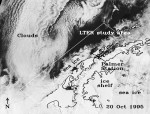Physical and biological systems traditionally are studied by different disciplines with different sets of terminology. But a recent article in BioScience by Palmer LTER (PAL) participants (R.Smith, K.Baker and S.Stammerjohn, 48(2):83-93,1998) bridges the gap between these disciplines. The article proposes a scientific method for quantifying physical forcing on biological systems. ‘Exploring Sea Ice Indexes for Polar Ecosystem Studies’ develops the concept of sea-ice indexes as the common vocabulary for the quantitative description of sea ice.
Sea ice is a complex matrix of physics and biology. How sea ice forms determines its internal structure, strength and thickness, as well as the amount of incorporated biological material, and ultimately, the amount of ocean covered—hence its function as both a biological platform for or barrier to the marine ecosystem.
Because of this complexity of physics and biology, a qualitative description of sea ice can create more confusion than insight. For example, a description such as "a high sea ice year" may refer to very different situations: i) a lot of sea ice at one particular time during the winter, or ii) lots of sea ice throughout the winter. Designating any particular year as a high sea-ice year is extremely vague, especially in the polar marine environment where seasonal and interannual variability are notoriously high, and such vagueness can lead easily to inconsistencies in its interpretation. These inconsistencies not only inhibit cross-comparisons but also limit the identification of the physical mechanisms forcing the variability in the marine ecosystem. In short, information such as the timing and duration of maximum sea ice extent are not conveyed in designating a year as having high or low sea ice.
The BioScience article, describing the wax and wane of sea ice over the 20 million km2 of Antarctic ocean, develops a set of systematic and quantitative indexes that describes both the magnitude and timing of sea ice. A variety of temporal scales are provided to capture both the seasonal and interannual variability of sea ice, and a variety of spatial scales are examined to emphasize the need to identify the appropriate spatial scale(s). For example, the spatial scale(s) must be defined based on both the geographical region of physical influence and the seasonal changes in distribution patterns within the ecosystem. Thus, suitable sea ice indexes not only provide a quantitative and consistent definition of the timing and magnitude of sea ice but also a common context to better resolve ice-ecosystem dynamics.
Although this particular study focuses on sea ice and the Antarctic marine ecosystem, the approach is applicable to any ecosystem study, as exemplified by many other LTERs. The approach requires communication between physical and biological scientists in order to determine the most appropriate biological spatial and temporal scales of physical forcing. One strength of LTER’s is that they are inherently multidisciplinary, making cross-discipline communication not only necessary but accessible. The scientific community at large benefits from the LTER example where a wealth of information is gained through cross-discipline communication.
Finding a Common Language: Quantifying Physical Forcing on Biological Systems Palmer LTER
By:
R.C. Smith (PAL) By:
K.S. Baker (PAL) By:
S.S. Stammerjohn (PAL) 
 Enlarge this image
Enlarge this image